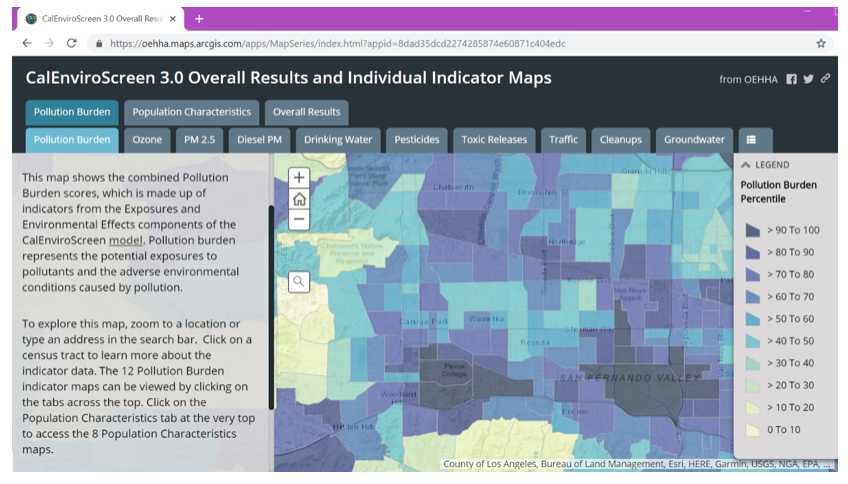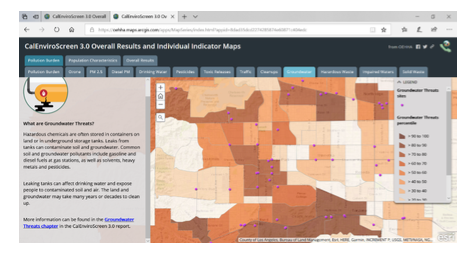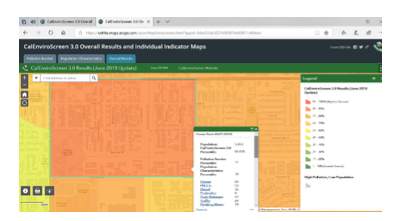CommentsENVIRONMENTAL POLITICS-When I think of Los Angeles County, and this is not a complete map of Los Angeles, I think of everything in our environment that potentially impacts public health.
This tool – CalEnviroscreen 3.0 Maps (screen shot above) – enables everyone to look at two characteristics – Pollution Burden and Population Burden and their combined factors to show how our health can be impacted. This is the link to the CalEnviroScreen Mapping Tool.
So, I must start by thanking the State of California’s Office of Environmental Health and Hazard Assessment (OEHHA) for this very valuable tool. The goal of this article is to bring to the attention of everyone some of the environmental and social factors that impact public health, and what other criteria the OEHHA employees consider have an impact on public health.
This tool can be used to consider the impacts of building residences near freeways – Diesel Emissions and Particulate Material are two of the Pollution Burden Criteria.

Pollution Burden map of Los Angeles County – The Pollution Burden tabs are headed by: Ozone, Particulate Matter 2.5 (PM – 2.5), Diesel Particulate Matter (Diesel PM), Drinking Water, Pesticides, Toxic Releases, Traffic, Cleanups, and Groundwater.

This map shows the Population Characteristics in the Los Angeles area – they include Asthma, Cardiovascular Disease, Low Birth Weight, Education, Housing Burden, Linguistic Isolation, Poverty, and Unemployment.
As a resident of the San Fernando Valley, my focus is on future planning in this area, as well as future cleanups of contaminated sites.

This is the Overall Results map for most of the San Fernando Valley. You will notice in the legend that the red is the highest score and the green is the lowest score.

This map shows the Pollution Burden in the Southwest San Fernando Valley.
Why is this map so important? The City of Los Angeles Planning Department is in its Environmental Review phase for the Southwest Valley Community Plan. So as the staff of City Planning considers rezoning any area, they should consider all of the factors of the Pollution Burden maps as they exist today, as well as the Population Characteristic factors in their planning.

This is a rough map of the Southwest Valley Planning area. The Planning area at this time would include the existing boundaries of the current community plans. This is the link to the Southwest Community Plan website.
The Southwest Community Plan includes the existing Community Plans of the Canoga Park, Winnetka, Woodland Hills, and West Hills Community Plan; the Encino – Tarzana Community Plan, and the Reseda – West Van Nuys Community Plan.
Currently the northern boundary for the Canoga Park, Winnetka, Woodland Hills, and West Hills Community Plan is Roscoe Boulevard.

This is the image of the current Canoga Park, Winnetka, Woodland Hills, and West Hills Community Plan.

This is the Ozone map for the Canoga Park – Winnetka – Woodland Hills – West Hills Community Plan area. You will notice that most the area is in the range of 80 – 90 % with 100 percent being the worst air for ozone. The legend on the side states that: “Ozone can irritate the lungs, cause inflammation, and make chronic illnesses worse, even at low levels of exposure. Children and the elderly are sensitive to the effects of ozone.”
Click on the Ozone tab at the top of the screen.

This image is the area of West Hills, Woodland Hills, Canoga Park, and Winnetka. It includes parts of Tarzana, Encino, Reseda, and Northridge. On this map link. Click on the Diesel PM tab at the top.
In the legend on the side regarding diesel particulate matter it states: “The particles in diesel PM can reach deep into the lung, where they can contribute to health problems including eye, throat and nose irritation, heart and lung disease, and lung cancer. Children and the elderly are most sensitive to the effects of diesel PM.”
Again, why is our air quality so important in these areas? There is a proposed project for a senior living community right next to the 101 freeway in Warner Center.

This is the Pesticide map for West Hills, Woodland Hills, Canoga Park, Winnetka, Tarzana and some other communities. The link for this map is here:
Again, click on the tab at the top of the page.
This is what the legend states to the left of the map: “What are pesticides?
Pesticides are chemicals used to control insects, weeds and plant diseases. Over 1,000 pesticides are registered for use in California. They are applied to fields by air, by farm machinery, or by workers on the ground.
Farmworker families and other people who live near fields can be exposed to pesticides, both outdoors and inside homes. Exposure to high levels of some pesticides can cause illness right away or conditions such as birth defects or cancer later in life.”

This is the Traffic Density map for West Hills, Woodland Hills, Canoga Park, Winnetka, Tarzana, parts of Encino, and parts of other communities. The link for this map can be found here.
The legend on the left of this map states: “What is traffic density?
California has the biggest network of freeways in the country. Its cities are known for heavy traffic. Traffic density is a measure of the number of vehicles on the roads in an area.
While California has strict vehicle-emissions standards, exhaust from cars and trucks is the main source of air pollution in much of the state. Major roads and highways can bring air pollutants and noise into nearby neighborhoods. Children who live or go to schools near busy roads have higher rates of asthma than children in areas farther from roads.”

This is the Hazardous Waste layer for the West Hills, Woodland Hills, Canoga Park, Winnetka, Tarzana, and Northridge areas.
Click the Hazardous waste tab.
The legend to the left of the map states: “What is Hazardous Waste?
Hazardous waste contains chemicals that may be harmful to health. Only certain facilities are allowed to treat, store or dispose of this type of waste. Hazardous waste can range from used automotive oil to highly toxic waste materials produced by factories and businesses. Hazardous waste is transported from businesses that generate waste to permitted facilities for recycling, treatment, storage or disposal.
Studies have found that hazardous waste facilities are often located near poor neighborhoods and communities of color.
Hazardous waste facilities often are cause for concerns about effects on health and the environment in the communities where they operate.”

This map represents Cleanup sites within the areas (or parts of areas) of West Hills, Woodland Hills, Canoga Park, Winnetka, Tarzana, Reseda, Northridge, and Chatsworth.
To the left of the map the legend states: “What are Cleanup Sites?
Cleanup sites are places that are contaminated with hazardous chemicals and require clean up by the property owners or government. Chemicals at cleanup sites can move through the air or groundwater. People living near these sites have a greater potential to be exposed to chemicals from the sites than people living further away.
Some studies have shown that neighborhoods with cleanup sites are generally poorer and have more people of color than other neighborhoods. The land may take many years or decades to clean up, reducing possible benefits to the community.”

Groundwater Threats map for West Hills, Woodland Hills, Canoga Park, Winnetka, Tarzana, and Northridge.
The legend to the left states: “What are Groundwater Threats?
Hazardous chemicals are often stored in containers on land or in underground storage tanks. Leaks from tanks can contaminate soil and groundwater. Common soil and groundwater pollutants include gasoline and diesel fuels at gas stations, as well as solvents, heavy metals and pesticides.
Leaking tanks can affect drinking water and expose people to contaminated soil and air. The land and groundwater may take many years or decades to clean up.”
This article does not allow me the time to demonstrate every tab of the CalEnviroScreen 3.0 Map tool.
So I want to conclude with showing you a more close-up map of an area in Warner Center:

The rectangle that is in the 91 – 100 percent area (worst overall score) is bounded by Sherman Way on the north, Vanowen on the south, Topanga Canyon on the west, and Variel on the east. This area has a planned residential unit on the north side of Vanowen between Canoga Avenue and Variel.
Finally, what the CalEnviroScreen 3.0 tool enables you to do is to click on a census tract for data as seen below:

Census Tract: 6037134520

Census Tract: 6037134520
This is the same census tract as above with the Population Characteristic map turned on. It has an Asthma score of 72, Low Birth Weight of 50%; Cardiovascular Disease at 72%; Education of 84%; Linguistic Isolation is 95%; Poverty is 79%; Unemployment is 23%; and Housing Burden is 84%.
Another tool at the bottom of that scroll down tab leads you to an interactive tab on the racial makeup of the census tract:

This census tract is just to the north of the proposed development at the former Canoga Avenue Rocketdyne facility. All of the factors that make up the CalEnviroScreen tool should be utilized in planning any future developments, and what type of developments should go in these locations.
For more information, please see the OEHHA CalEnviroScreen website.
(Chris Rowe has been a 41-year resident of West Hills, was a former West Hills Neighborhood Council Board Member, and has a B.S. in health education. She can be reached at [email protected]. Prepped for CityWatch by Linda Abrams.
















